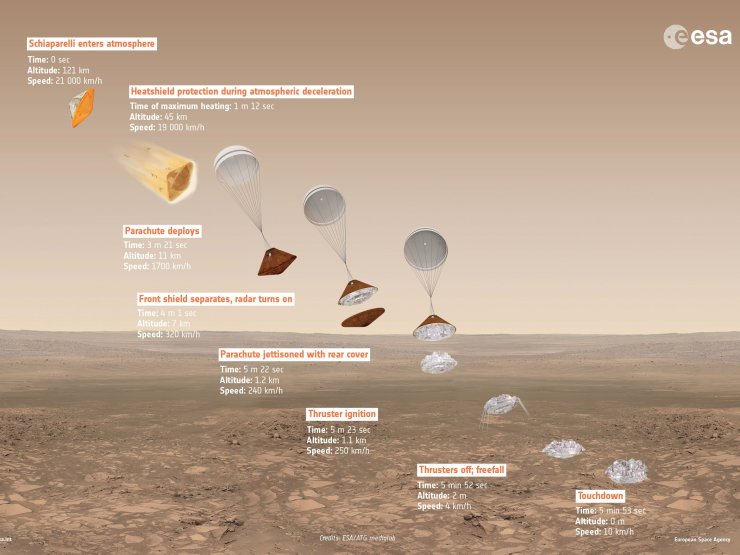 Credit: European Space Agency
Credit: European Space Agency
 By Jonathan Stroud
By Jonathan Stroud
JournalistsForSpace.com
*Update (10/20/16): The ESA speculates that Schiaparelli may have crashed on Mars due to parachute and thruster problems. The ESA is still investigating the specific cause and the exact status of the lander.
Update (10/21/16): The ESA has confirmed the lander crashed.
Wednesday, Oct. 19, 2016, the European Space Agency’s (ESA) Schiaparelli EDM lander attempted to land on the surface of Mars.
As of this time, the success of this landing is unconfirmed. The ESA will work through the night to assess if Schiaparelli reached the surface safely. The Trace Gas Orbiter (TGO) spacecraft, which carried the probe to Mars, is confirmed to be in orbit around Mars after detaching and performing a successful 139-minute burn.
Launched in March 2016 as part of the Exo Mars mission, the Schiaparelli probe was designed to demonstrate the ESA’s landing technology. Whether the landing was successful or not, scientists will still be able to gather critical landing data helping to facilitate future missions.
If Schiaparelli landed on the surface safely, its batteries will support operations for three to ten days. During that time, the onboard atmospheric study package—the DREAMS package—will collect crucial data about the Martian environment. Scientists will know the status of this equipment once communication with the lander is established.
Schiaparelli is pre-programmed to perform an automated landing sequence. It initially utilizes the thin Martian atmosphere for drag to decelerate the spacecraft. Approximately three-minutes into the descent, the parachute is designed to deploy to provide additional deceleration. Once the probe is approximately a kilometer above the ground, the parachute detaches and the thrusters begin to burn for 30 seconds. This leaves the craft traveling at a few meters per second once it is a few meters above the Martian surface. The crushable honeycomb structure at the base of the probe cushions the landing. The execution and success of these procedures is not yet confirmed.
Why Is This Cool?
If the landing was successful, the Schiaparelli craft, named after the Italian astronomer Giovanni Schiaparelli who observed and mapped the surface of Mars in the late 19th century, would be a historic first for both the ESA and Russia’s space program, Roscosmos, whom partnered for this mission.
This mission is also significant because the information collected from the landing and the data collected on the Martian surface will expand scientists’ current understanding of Mars, which will help with future manned missions to Mars.
Why Should I Care?
Sending various types of rovers and spacecrafts to Mars, such as the Schiaparelli probe, help to further scientists’ understanding of Mars, allowing them to refine technology that will help put humans on Mars.

The newly developed DREAMS package, known as the “Dust Characterisation, Risk Assessment, and Environment Analyser on the Martian Surface,” onboard the Schiaparelli craft will collect data about the Martian environment for the next few days if the landing was a success. With a variety of sensors, the DREAMS package can measure Mars’ wind speed and direction, humidity, pressure, atmospheric temperature close to the surface, transparency of the atmosphere, and atmospheric electrification.
Keep up with the latest Schiaparelli news and other space-related content at Journalists For Space.


Zane is going to be gutted. He was so excited about this landing.
LikeLike
Hiya, I contacted you via your email address, my message may have gone into your Junk Mail folder.
LikeLike